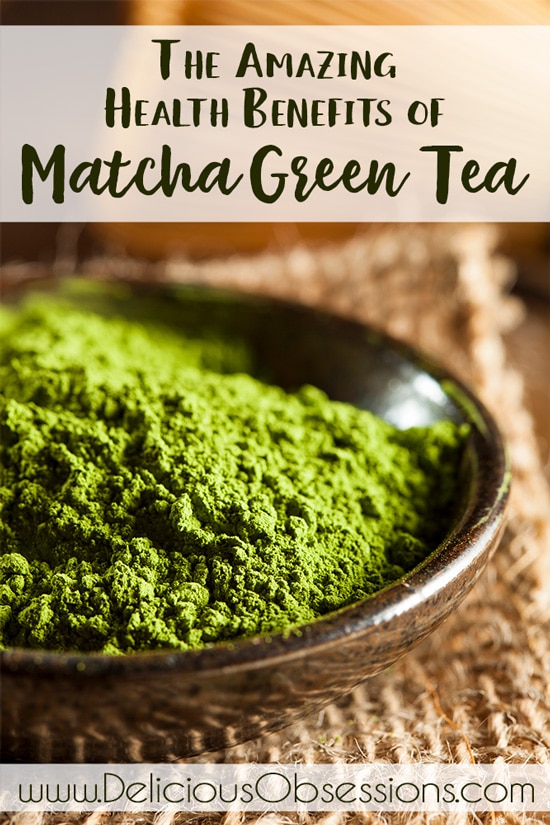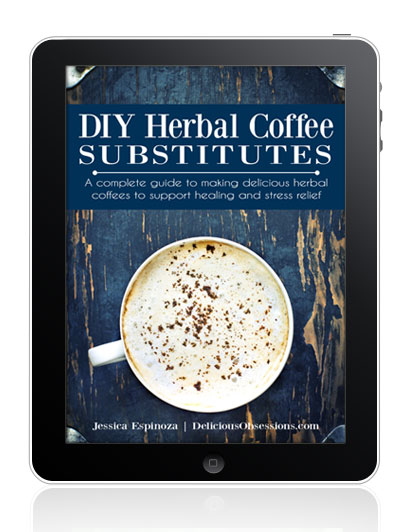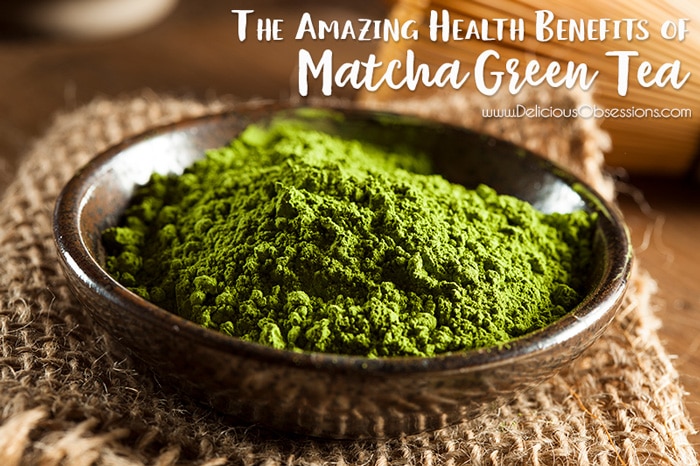FTC Disclosure: Delicious Obsessions may receive comissions from purchases made through links in this article. As an Amazon Associate I earn from qualifying purchases.Read our full terms and conditions here.
Boy oh boy, I have been on a major matcha tea kick as of late. I can’t seem to get enough of the delicious, earthy, grassy flavor of this amazing tea. Something about it is so soothing to my soul, and it’s definitely one of my favorite things to drink in the mornings as I kick off my day.
I initially started drinking matcha green tea lattes from coffee shops about 15 years ago and became hooked. Even though the matcha that is typically used in most coffee shops is not that great of quality, I still fell in love with the taste and aroma. It became a welcome addition to my days — some may say a bit of an addiction at one point in my life where stress was high and I was feeling pretty miserable with life and career (Steph, are you reading this?).
I’ve always been a fan of green tea, but specifically matcha. About 9 months ago, I decided that I wanted to add a few caffeinated teas back into my diet. I missed black tea (though I have an awesome herbal “black” tea recipe that I’ll be posting soon) and matcha. I discovered that coffee is still out for me. I tried reintroducing that and was not able to tolerate it (regular or decaf). But, matcha…ahhh….yes….no problems there. Woot!
Adding matcha back into my diet was a bit of a celebration for me. You see, I was totally caffeine-free for over 4 years. No coffee, no black tea, no green tea, no white tea, nothing with caffeine.
I avoided it all.
I relied heavily on my super popular herbal “coffee” blends which kept my cravings for coffee at bay and made the whole “giving up coffee for the sake of health” thing a little easier. I still drink my herbal coffees several times a week and love knowing that they are supporting my health via the nourishing herbs that they are made of. That and they are frankly so delicious that I think I prefer them over coffee!
Anywho, about 9 months ago, I finally felt that I had healed to a point where adding these teas back in would not cause any problems, so I slowly reintroduced black and green teas and have been doing just fine with them. I have no desire to drink them every day, but I am happy to have them back in the rotation here and there when I want them.
For me, caffeine has never affected me as in giving me a buzz or energy. It’s not something I ever needed to “get going.” I used to joke that I could drink a 6-pack of Mountain Dew and go right to bed. But, caffeine was one of the things that I needed to eliminate while I focused on healing my adrenals (and other health issues) so I said goodbye to it for awhile. If you’re not familiar with the impact caffeine can have on your health, read this post.
Now that matcha is back in my life, I know it is a beverage that will always hold a special place in my heart. Since I love it so much I wanted to know more about it, so I decided to dig into the health benefits of matcha and wanted to share some of what I learned along the way. I also have a super simple and super delicious superfood matcha latte recipe that you can get here. If you’re not already subscribed to my newsletter, you can do that here so you’ll be notified when we publish tasty new recipes or health info (and you’ll get a free eBook too). 🙂
For now, let’s learn a little about matcha, its history, and its health benefits.
History of Matcha Green Tea
Before its global popularity, matcha began its fascinating journey first in China and then spread to Japan through Zen Buddhism before it became the main centerpiece of Japanese tea ceremonies. Now, it has exploded onto the health scene for its variety of health benefits and has become wildly popular.
Matcha comes from the plant Camellia sinensis, which is also known as the “tea plant,” “tea shrub,” or “tea tree.” In China, during the Tang Dynasty in the 7th-10th centuries, the development and cultivation of green tea started. Once the tea was harvested, they were steamed and formed into tea bricks, which were created for storage and trade. To prepare these bricks for tea consumption, the tea leaves were roasted and pulverized and then brewed with hot water and a pinch of salt would be added before drinking it.
From there, the process evolved in the 10th-13th centuries during the Song Dynasty. The method involved grinding the steamed tea leaves to make a powder, and then prepare the beverage by whipping the tea powder with hot water. This method became so popular that Zen Buddhist monks started using it in their daily rituals. They saw meditational benefits from drinking the matcha before they sat in stillness. The matcha brought them sustained energy, mental clarity, the ability to become more centered and focused, and a greater sense of well-being.
Because of the way these monks prepared and consumed the tea, this special green tea became known as “Matcha, the ceremonial tea of the temple high priests.” Even Shoguns, or warriors, saw the benefits of this ceremonial tea and started to drink it before going into battle, which gave them more energy and mental acuity.
Eventually, this Chinese powdered tea was brought to Japan in 1191 by an influential Japanese Zen Buddhist monk, Eisai Myoan. He saw the tea as precious medicine and is famously quoted as calling it, the “elixir of the immortals.” He encouraged the Japanese people to make a habit of drinking this tea for its health benefits.
In the early days, matcha was extremely precious where only the Shogun and nobility were able to drink it because it was produced in such tiny quantities due to the time-consuming process of making it. However, in 1738 Sohen Nagatani invented the “Uji” green tea method, which is still practiced and used today. It’s a much more efficient process to make matcha that is available to the masses. Nagatani wanted the common people to have access to matcha as well, so he began teaching his secret of the Uji process to the farmers, which had a huge impact on the development of the entire Uji region of Kyoto.
3 Grades of Matcha Green Tea
In its early days, matcha was viewed more as a medicine and had a bitter flavor profile. However, in the 15th and 16th centuries, Japanese tea growers discovered that shading the tea plants 20-30 days before harvest created a smooth, mellow, umami-sweet taste in the tea leaves.
Today, you can choose the quality of matcha, which will affect the taste, ranging from bitter to sweet. In general, the more expensive it is, the sweeter it will be, and the cheaper it is, the more bitter tasting it will be. That said, I have tried a couple cooking/culinary grade brands that have tasted great, but I also really like bitter flavors so maybe I am not noticing the bitterness the way others would.
Matcha is categorized into three different grades:
- Ceremonial Grade: This is the highest quality that is used in Buddhist temples and tea ceremonies. It’s also the most expensive powder that is stone ground by granite stone mills. Inexperienced drinkers most likely won’t notice a difference between ceremonial and premium grade. Ceremonial is often characterized by subtle tones of “Umami.” The color is a vibrant green and is extremely fine texture, not gritty or coarse. The powder should smell fresh and a little grassy. It has a very delicate taste, naturally sweet, and a mild, smooth flavor. It’s best enjoyed pure and mixed only with hot water. This is my favorite ceremonial grade matcha (use coupon code WILDDELICIOUS to save 12% on your order).
- Premium Grade: This is high-quality matcha that is best for daily consumption, like lattes and smoothies, and still contains the full range of antioxidants, vitamins, and minerals. This grade uses tea leaves from the top of the tea plant. Premium is often characterized by a fresh, subtle flavor, which is perfect for both new and everyday matcha green tea drinkers. The color is less vibrant than the ceremonial grade and it also has a fine texture that breaks up easily in water.
- Cooking/Culinary Grade: This is the cheapest of the three grades because it lacks all the health benefits and is more suitable for cooking purposes. These leaves are used from the lower portion of the green tea plant, therefore, it’s slightly bitter and has a more robust flavor. The color is noticeably less vibrant than the ceremonial and premium grades but it still has a green hue to it. It should also smell fresh and grassy, and feel soft and smooth.

The Amazing Health Benefits of Matcha Green Tea
Now onto the good stuff! There are a huge variety of health benefits from drinking matcha:
- Reduces stress and anxiety, resulting in an alert calm
- Enhances mood
- Increases focus and mental clarity
- Increases energy and endurance
- Lowers blood pressure and blood sugar
- Improves cholesterol
- Reduces the risk of heart disease, stroke, and diabetes
- Boosts your metabolism and aids in weight loss
- Aids in speedy recovery from high-intensity workouts
- Supports skin health
- Supports a healthy immune system
- Reduces inflammation
- Helps the body eliminate heavy metals and other harmful toxins and chemicals
- May help in preventing cancer and other diseases
Here are some more amazing facts about matcha green tea:
- Matcha is estimated to be 10 times stronger than regular brewed green tea, so it has extremely therapeutic effects on the body.
- Matcha contains over 70 times the antioxidants of fresh orange juice and over 9 times the beta carotene of spinach.
- Matcha contains high amounts of L-Theanines, a unique set of natural amino acids.
- Matcha is the healthiest energy drink with basically zero calories and without any side effects that can be found in the high-sugared typical energy drinks sold in stores.
- You consume an entire tea leaf when you drink a matcha beverage, so you’ll get the full amount of antioxidants, amino acids, vitamins, minerals, and fiber in one drink!
If you’re ready to give matcha a try, make sure you check out my Superfood Matcha Latte Recipe (it’s gluten, grain, dairy, and sugar free). I also talk about what brands I am personally using (at the time of writing this).
My Favorite Matcha – Ceremonial Grade at an Affordable Price
There are a TON of matcha brands on the market and I’ve tried a lot of them. My all-time favorite though comes from Wild Foods. It is the perfect balance of taste and affordability. Some matcha varieties (i.e. ceremonial grade) taste amazing, but can be quite expensive, while the cheaper varieties (i.e. culinary) may not have the best taste even though they are more affordable.
Ceremonial grade is my favorite because it has the richest, most robust flavor. Wild Foods brand is actually classified as ceremonial AND it is affordable. I have tested it against more expensive ceremonial grade matcha and I can’t tell much difference. So this is the brand I buy. I am actually expecting my delivery to show up this week and it’s perfect timing because my current bag is almost empty!
If you would like to check out Wild Foods matcha, you can find it on their site here. Use coupon code: WILDDELICIOUS to save 12% off on your order. I also use a number of other products from them, including their Men’s and Women’s multis, fish oil, magnesium, and cocoa powder. They have great stuff and they work hard to keep their prices down as much as they can.
Not Ready for Green Tea or Caffeine?
If you are still deep in your healing journey or just avoiding caffeine for other reasons, then I have a great option for you: herbal “coffees”! I developed these herbal blends when I had to give up coffee completely and needed something to take its place. Coffee, for me, was always a bit of a spiritual experience. It was something that calmed my soul, especially during a time in life where I was needing a lot of extra soothing.
When I gave up coffee completely, I tried to focus solely on herbal teas as a replacement, but the taste, aroma, and mouthfeel was beyond lacking for me. That’s why I decided to turn to herbs that could give me a similar experience as a freshly brewed cup of coffee. Thankfully such herbs exist and I created a handful of blends that did just the trick. It took a lot of experimenting, but I finally got the proportions right and had a new cuppa joe to soothe my soul. 🙂
I now have these recipes (the very ones that I used when I sold this line of herbal “coffees” online), in my DIY Herbal Coffee Substitutes Blending Guide. Not only do you get access to the recipes I created, you get a TON of info about coffee, caffeine, health, and the nutrition of these herbs. Oh, and did I mention that there are a bunch of coffee shop inspired beverage recipes too? If you’ve got a favorite, then it’s likely in there.

If you’ve had to give up caffeine and herbal coffee is just not cutting it, then this is the book for you. Not only will these recipes soothe your coffee tooth, they will also support (and possibly) improve your health thanks to the nourishing herbs used.
For a limited time, I am offering Delicious Obsessions readers a special 50% OFF coupon code for my DIY Herbal Coffee Substitutes Blending Guide. Use coupon code COFFEE at checkout to save. Learn more and download your copy today here.
Here’s to YOUR health, with love,

~~~~~~~~
Further Reading
If you want to learn more about matcha green tea, check out these resources:
- Wikipedia – Matcha
- A Brief History of Matcha
- History of Matcha
- Discover the Different Grades of Matcha Green Tea Powder
- 7 Benefits of Matcha Green Tea
- Matcha Green Tea Helps Burn Fat & Fight Cancer
- Health Benefits of Matcha Tea


2 Comments